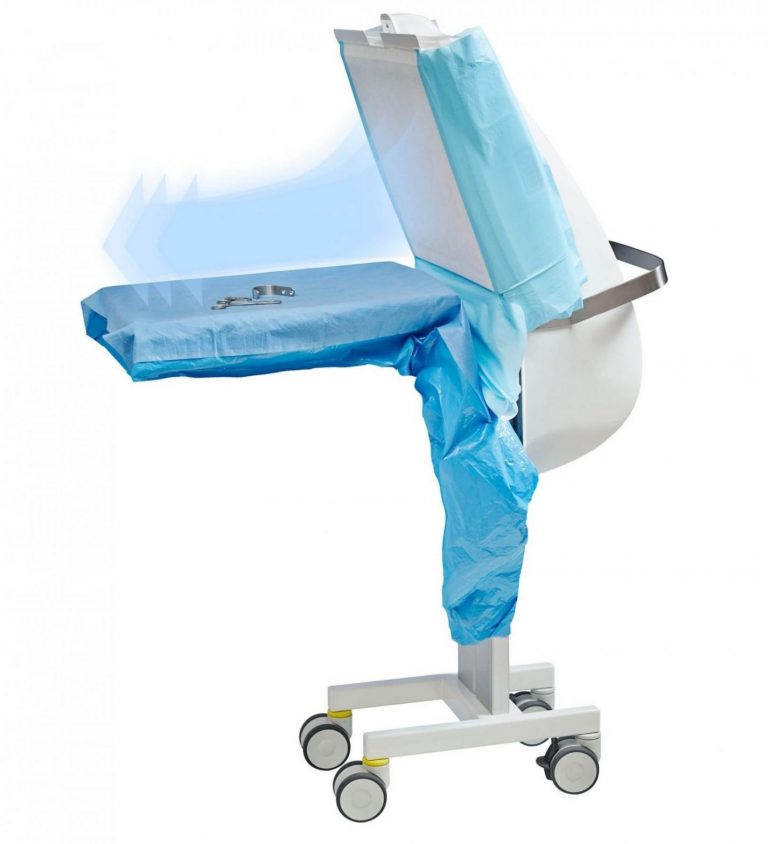
Operating theatre ventilation for cardiac surgery
The Solution: Operio and Steristay for Maximum Hygiene in Cardiac Surgery
Operio: Mobile Laminar Air Flow for Sterile Conditions
- Targeted Sterile Protection Zones
- Operio creates focused sterile airflow directly over the surgical field and instruments, unaffected by operating lights or staff movements.
- Reduces airborne contamination by up to 99.9% with a three-stage filtration system featuring a HEPA H14 filter.
- Effective Infection Prevention
- Minimizes the risk of postoperative wound infections, reducing the reliance on antibiotics.
- Ideal for patients with weakened immune systems or in critical health conditions.
- Flexibility and Easy Integration
- Operio is fully mobile and ready to use immediately, making it perfect for integration into existing operating rooms.
- Cost Savings
- Prevents expensive infection-related costs and reduces the need for re-sterilization processes.
Steristay: Sterile Instrument Tables for Maximum Safety
- Sterile Protection for Instruments
- Steristay keeps surgical instruments sterile throughout the entire procedure, even during long surgeries.
- Shields instruments from contamination caused by uncontrolled airflow or staff movements.
- Ergonomic and Efficient Design
- Features adjustable height for optimal positioning in the operating room.
- User-friendly design improves workflow efficiency for surgical teams.
- Easy Integration
- Seamlessly integrates into operating rooms with existing ventilation systems, enhancing hygiene without additional infrastructure changes.
- Highest Hygiene Standards
- Significantly reduces contamination risks in the surgical field, protecting implants and instruments during critical procedures.

Key Benefits of Operio and Steristay for Cardiac Surgery
- Maximum Infection Prevention
- Ensures sterile conditions, even during prolonged and complex procedures.
- Protects against bacterial contamination and significantly reduces infection risks.
- Enhanced Patient Safety
- Reduces complications caused by contamination, ensuring safer outcomes for cardiac patients.
- Cost Efficiency
- Prevents infection-related costs and reduces reliance on antibiotics, lowering overall healthcare expenses.
- Optimal Flexibility
- Both Operio and Steristay are mobile and easily integrated into modern and existing operating rooms.
Applications in Cardiac Surgery
- Prolonged Surgical Procedures
- Operio and Steristay safeguard the surgical field and instruments throughout long surgeries, ensuring consistent sterility.
- Critical Patients
- Provides superior hygiene standards for patients with compromised immune systems or critical conditions.
- Combatting Multidrug-Resistant Pathogens
- Reduces infection risks and minimizes dependence on antibiotics, improving patient outcomes.
Why Choose Operio and Steristay?
- Advanced Sterile Airflow: Operio delivers ISO 5 conditions directly to critical zones with HEPA H14 filtration.
- Instrument Protection: Steristay keeps instruments sterile throughout surgery, even during extended procedures.
- Flexibility and Convenience: Both solutions are mobile, cost-effective, and require no infrastructure changes.
- Patient Safety: Provides unmatched infection prevention for vulnerable cardiac patients, enhancing surgical outcomes.
Cost of a deep sternal wound infection in cardiac surgery
Although the incidence of sternal wound infections has decreased they continue to be associated with increased morbidity and mortality, and decreased long-term life expectancy.1-3 They prolong hospital length of stay and can raise hospital costs by as much as US$62,000. (Braxton JH, Marrin CA, McGrath PD, Ross CS, Morton JR, Norotsky M, et al. Mediastinitis and long-term survival after coronary artery bypass graft surgery. Ann Thorac Surg. 2000;70:2004-7.)
The average incidence rate of Deep Sternal Wound Infections (DSWI) ranges from 0.5% to 6% in the immediate postoperative period and ranges from 0,3% to 7.3% in a 90 day follow up period. (Rupprecht L, Schmid C. Deep Sternal Wound Complications: An Overview of Old and New Therapeutic Options. Open Journal of Cardiovascular Surgery 2013:6)
Get in Touch with Normeditec
We’re here to help you enhance your surgical solutions with the Operio Mobile Laminar Air Flow Unit. Contact us for expert advice, product information, or assistance.
Contact Information
Email: info@normeditec.com
Phone:
- Germany: +49 7139 2090859
- Italy: +39 348 730 24 45
WhatsApp Support:
- Germany: +49 176 62 13 16 34
- Italy: +39 348 730 24 45
Languages Spoken: English, German, French, Italian
Website: www.normeditec.com
We deliver worldwide and are available via video call for support and guidance. Let’s make advanced aseptic solutions accessible to your practice today!
Benefits:
trapianto cardiaco
chirurgia cardiaca a cuore aperto/battente
bypass aortocoronarico, bypass coronarico
angioplastica coronarica
interventi sull’aorta
impianto di pacemaker
sostituzione valvolare con protesi artificiale o biologica
plastica valvolare
cateteri venosi impiantabili
chirurgia cardio-toracica
chirurgia toracica: toracotomie per interventi di carcinoma dell’esofago, per riparazione ernia iatale
Related products

Operio portable laminar air flow
The Operio Mobile Laminar Air Flow Unit provides ISO 5 sterile conditions, transforming conventional operating rooms and outpatient surgical spaces into ultra-clean environments. Its focused sterile airflow protects the surgical field and instruments, ensuring maximum sterility for eye surgeries, ENT procedures, day surgeries, cardiology, all types of implant surgeries, plastic and aesthetic surgeries, orthopedic operations, and more. Ideal for enhancing infection control and surgical precision across diverse medical disciplines.
Go to product
Steristay instrument table with hepa filter
TOUL Steristay– Focused laminar flow with built-in backtable is ideal to keep the surgical instruments sterile. While implants are opened only at the last moment to ensure sterility, the instruments used for implantation remain exposed on traditional instrument tables. This exposure significantly increases the risk of contamination and surgical site infections.
Go to product
 it
it en
en fr
fr de
de








